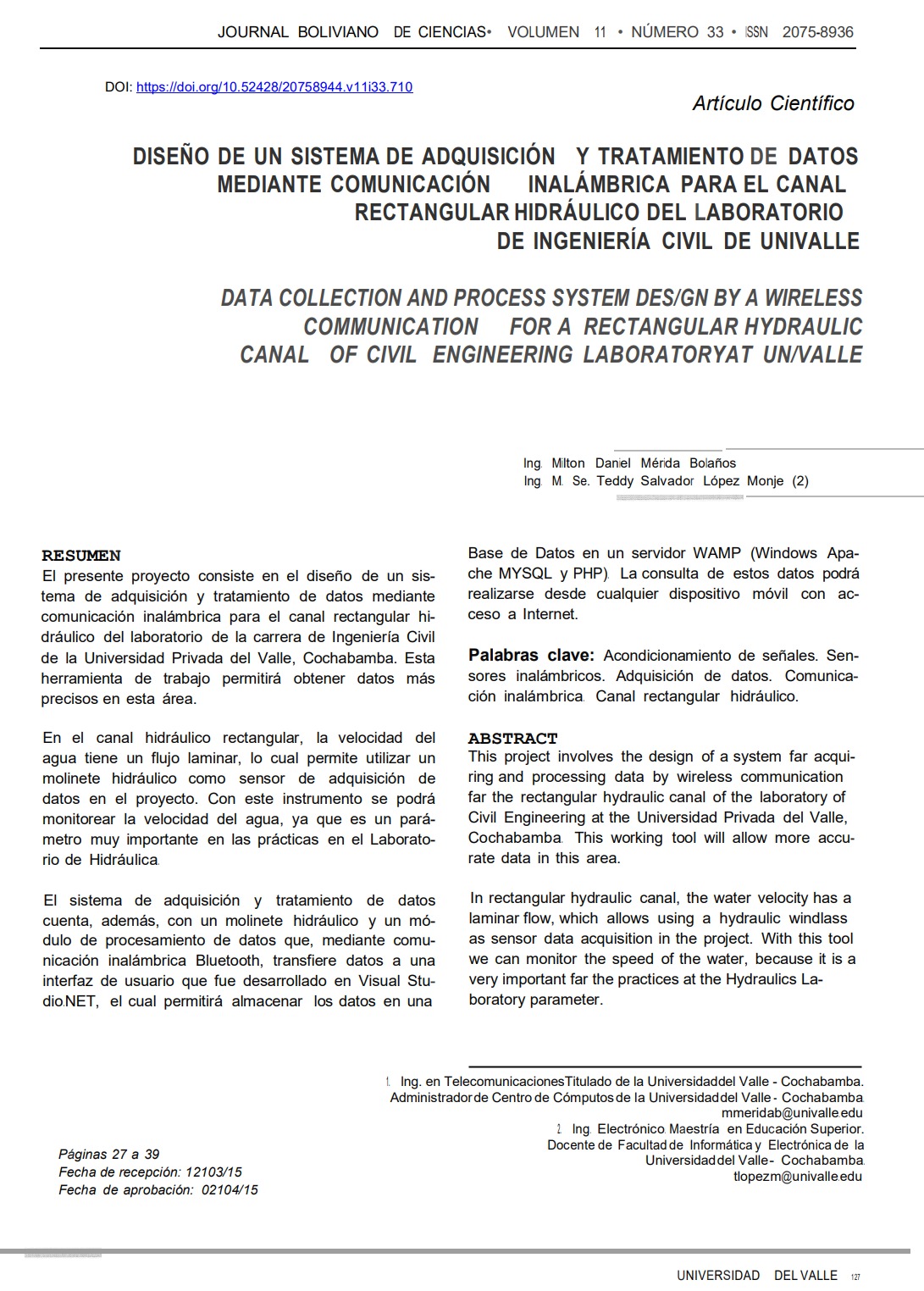Data Collection and Process System Design by a Wireless Communiction for a Rectangular Hydraulic Canal of Civil Engineering Laboratory at Univalle
DOI:
https://doi.org/10.52428/20758944.v11i33.710Keywords:
Signal Conditioning, Wireless Sensors, Data Acquisition, Wireless Communication, Hydraulic rectangular canalAbstract
This project involves the design of a system far acquiring and processing data by wireless communication far the rectangular hydraulic canal of the laboratory of Civil Engineering at the Universidad Privada del Valle, Cochabamba. This working tool will allow more accurate data in this area. In rectangular hydraulic canal, the water velocity has a laminar flow, which allows using a hydraulic windlass as sensor data acquisition in the project. With this tool we can monitor the speed of the water, because it is a very important far the practices at the Hydraulics Laboratory parameter. The data acquisition and data processing also has a hydraulic winch and a processing module data through Bluetooth wireless communication, which transfers data at a user interface that was developed in Visual Studio.NET, to store data in a database on a server WAMP (Windows Apache MySQL and PHP). The query of these data may be made from any mobile device with Internet access.
Downloads
References
(1) CAMACHO G. Laboratorio de Hidráulica. Brújula Universitaria, Universidad Privada Del Valle.
(2) TECMES. Micromolinete Digital. [En línea]. [Fecha de acceso 3 de Diciembre de 2012]. URL disponible en: http://www.tecmes.com/correntometro.pdf.
(3) HIGHLY. Sensor Inductivo TS12 Shield. [En línea]. [Fecha de acceso 9 de Enero de 2013]. URL disponible en: http://www.highly.com/highly/pdf/proximity.pdf.
(4) HC Serial Bluetooth Products - User lnstructional Manual. [En línea]. [Fecha de acceso 4 de Diciembre de 2012]. URL disponible en: http://www.tec.reutling en-un ive rsity. de/u ploads/med ia/DatenblattH C- 05_BT-Modul.pdf.
(5) RUIZ G. ¿Qué es Bluetooth? [En línea]. [Fecha de acceso 9 de Enero de 2013]. URL disponible en: http://tecnyo.com/ ¿que-es-bluetooth/.
(6) RUIZ A. Servidores WAMP. [En línea]. [Fecha de acceso 5 de Mayo de 2013]. URL disponible en: http://recursostic.educacion.es/observatorio/web/es/softwa re/servid o res/800-mo n og raf ico-se rvi do reswamp.
(7) DONAYRE J. Sensores Inductivos. [En línea]. [Fecha de acceso 9 de Enero de 2013]. URL disponible en: http://www.mes-sigma.net.
(8) ARDUINO. ArduinoBoardNano. [En línea]. [Fecha de acceso 2 de Mayo de 2013]. URL disponible en: http //ArduinoArduinoBoardNano_files/widget112.ccs.
(9) ÁLVAREZ D. Capitulo 6 Comunicación 12C. [En línea]. [Fecha de acceso 27 de Abril de 27]. URL disponible en: http://tallerarduino.worpress.com.
(10) ÁLVAREZ D. Capitulo 4 Interrupciones. [En línea]. [Fecha de acceso 26 de Abril de 2013]. URL disponible en: http://tallerarduino.worpress.com.
(11) WIKIPEDIA. Visual Studio.NET. [En línea]. [Fecha de acceso 25 de Marzo de 2013]. URL disponible en: http://es.wikipedia.org/wikiNisual_Studio_.NET.
(12) HIDRÁULICA LD. Distribución De Velocidades. Guía de laboratorio hidráulica 11, Universidad Privada Del Valle. ;: p. Guía de laboratorio hidráulica 11.

Downloads
Published
How to Cite
Issue
Section
License
Copyright (c) 2015 Teddy Salvador López Monje y Daniel Mérida Bolaños

This work is licensed under a Creative Commons Attribution 4.0 International License.
Authors who publish with this journal agree to the following terms:
- Authors retain copyright and grant the journal right of first publication with the work simultaneously licensed under a Creative Commons Attribution License 4.0 that allows others to share the work with an acknowledgement of the work's authorship and initial publication in this journal.
- Authors are able to enter into separate, additional contractual arrangements for the non-exclusive distribution of the journal's published version of the work (e.g., post it to an institutional repository or publish it in a book), with an acknowledgement of its initial publication in this journal.
- Authors are permitted and encouraged to post their work online (e.g., in institutional repositories or on their website) prior to and during the submission process, as it can lead to productive exchanges, as well as earlier and greater citation of published work.














